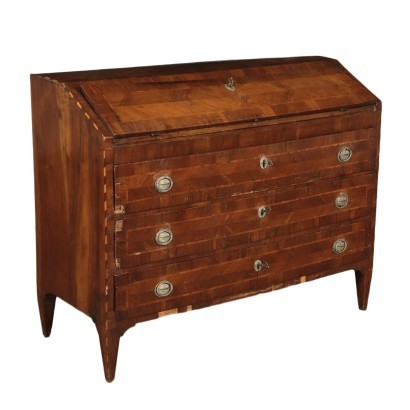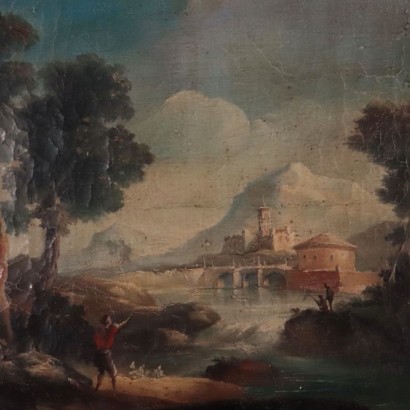Neo-Classical Venetian Drop-Leaf Secretaire, Italy 18th Century
Features
Style: Neo-Classical (1765-1790)
Age: 18th Century / 1701 - 1800
Origin: Veneto, Italy
Description
Venetian Neo-Classical drop-leaf secretaire; supported by 4 truncated pyramidal legs; 3 frontal drawers surmounted by a folding door that hides a compartment with drawers and central opening. Four-parts waknut veneered drawers with olive treadings; spruce inners. Nees restoration works.
Product Condition:
Fair condition. Wear consistent with age and use.
Dimensions (cm):
Height: 101,5
Width: 126
Depth: 51
With certificate of authenticity
Certificate issued by: Enrico Sala
Additional Information
Style: Neo-Classical (1765-1790)
This historical period includes a first phase that can be properly defined as the Louis XVI style.nOnly at a later time, with the maturation of archaeological fashions, was a new vision of furnishing civilization formulated and codified, now fully attributable to the Neoclassical Style.
In fact, both trends coexisted in unison until the last years of the eighteenth century.
nIn the field of cabinet making, the Directoire, Retour d'Egypte, Consular and Empire styles also fall within the neoclassical era.
nFind out more about Neoclassicism with the insights from our blog...
n
Age: 18th Century / 1701 - 1800
18th Century / 1701 - 1800Main essence:
Walnut
Walnut wood comes from the plant whose botanical name is juglans regia , probably originally from the East but very common in Europe. Light or dark brown in color, it is a hard wood with a beautiful grain, widely used in antique furniture. It was the main essence in Italy throughout the Renaissance and later had a good diffusion in Europe, especially in England, until the advent of mahogany. It was used for solid wood furniture and sometimes carvings and inlays, its only big limitation is that it suffers a lot from woodworm. In France it was widely used more than anything else in the provinces. In the second half of the eighteenth century its use decreased significantly because mahogany and other exotic woods were preferred.Olive
Extracted from the plant called olea europaea which lives in all the Mediterranean lands, it is a hard and compact wood. It has a characteristic light color, greenish yellow, with particular dark veins. It is widely used in cabinet making both as a solid wood for entire furniture, and for inlays, veneers and decorations. As it is very hard, it is also suitable for round work and for the manufacture of small objects. It could also interest you




































